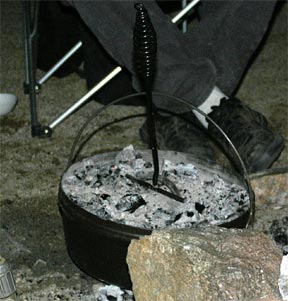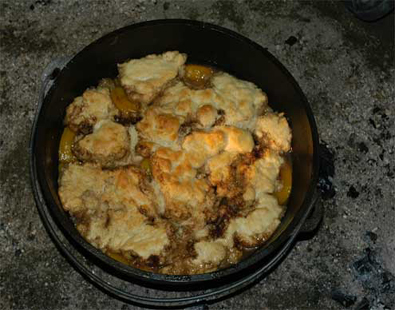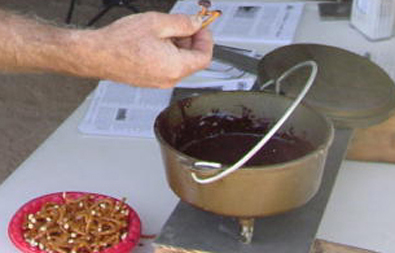
|
A Dutch oven is actually a cooking pot that’s designed to be heated by charcoal or a campfire. They are made of cast iron because iron offers a uniform distribution of heat. Dutch ovens are most often used for baking goods, but are also used to cook with. People make soups, casseroles, and other dishes with a Dutch oven.

|
The ovens come in a variety of sizes, with the most common being 10” and 12” wide. A 12” pot holds six quarts of food and will serve four to six people. For two to four people, a 10” pot should be sufficient. Be sure you purchase a "camp" oven with 3 little legs and a lip on the lid to hold hot coals.
New ovens have a waxy coating to prevent rusting. Wash in soap and water to remove the coating. The next step is to "season" your pot. Use a paper towel to apply a light coat of vegetable oil (many people use Crisco brand) to all surfaces of the pot and lid inside and out. Do not use lard or other animal fat. It will turn rancid over time.
Place the covered pot in your gas grille, close the lid, and heat to 425 degrees, baking for one and one-half to two hours. This process causes a lot of smoke, so don’t be alarmed. Season several times to give your oven a nice, non-stick surface.
Now you’re ready to cook. Since most folks use charcoal we’ll focus on that. To determine how much charcoal to use, remember the “plus 3/minus 3” rule. Add three coals to the size of your pot for the lid. Subtract three to get the number of coals needed underneath. So, for a 12” pot, you’d use 15 briquettes on the lid and nine underneath.

|
Most dishes and baked goods cook in 45 minutes to an hour. Rotate the oven every 15 minutes to ensure even heating, and be careful when serving your meal. The oven is heavy and very hot.
Some Do’s and Don’ts to consider:
- Do clean out the pot after every meal. Condensation will form on any leftover food, which will cause the pot to rust. A paper towel is usually all you’ll need to remove food scraps.
- Don’t store without drying. Wipe it thoroughly with a towel or heat the oven over a stove.
- Don’t clean with soap. The porous surface of the oven will capture some of the soap, resulting in an after taste. If the oven has been cleaned with soap, rinse it thoroughly with hot water.
- Don’t use steel wool or abrasive cleaners. These will scratch off the seasoning and make the oven susceptible to rusting. However, you can use steel wool to remove rust spots.
Dutch ovens are a great way to bring authentic cooking to the outdoors. With a little practice you can become a hit with your friends during your next off-road adventure.
I hope to see you on the trails!
Tom Severin, President
Badlands Off Road Adventures, Inc
4-Wheel Drive School
310-613-5473
http://www.4x4training.com
Make it Fun. Make it Safe.
###
If you find this information valuable, please pass it on to a friend. You can forward them the email.
If you received a forwarded copy of this newsletter and would like to subscribe for yourself, go to: www.4x4training.com/contacts.html
and follow the instructions to join our mail list.
You are receiving this email because you have attended one of our events or have signed up to be on the distribution list.
If you no longer wish to be on the distribution list please contact me and I will personally take you off the list immediately.
You are identified as Montego Bay with email address of Montego@RoughWheelers.com on our email list.
###
Want To Use This Article In Your Magazine, E-Zine, Club Newsletter Or Web Site?
You are welcome to use it anytime, just be sure to include the following author/copyright information:
Tom Severin, 4x4 Coach, teaches 4WD owners how to confidently and safely use their vehicles to the fullest extent in difficult
terrain and adverse driving conditions.
Visit www.4x4training.com to develop or improve your driving skill.
Copyright 2008, Badlands Off-Road Adventures, Inc.